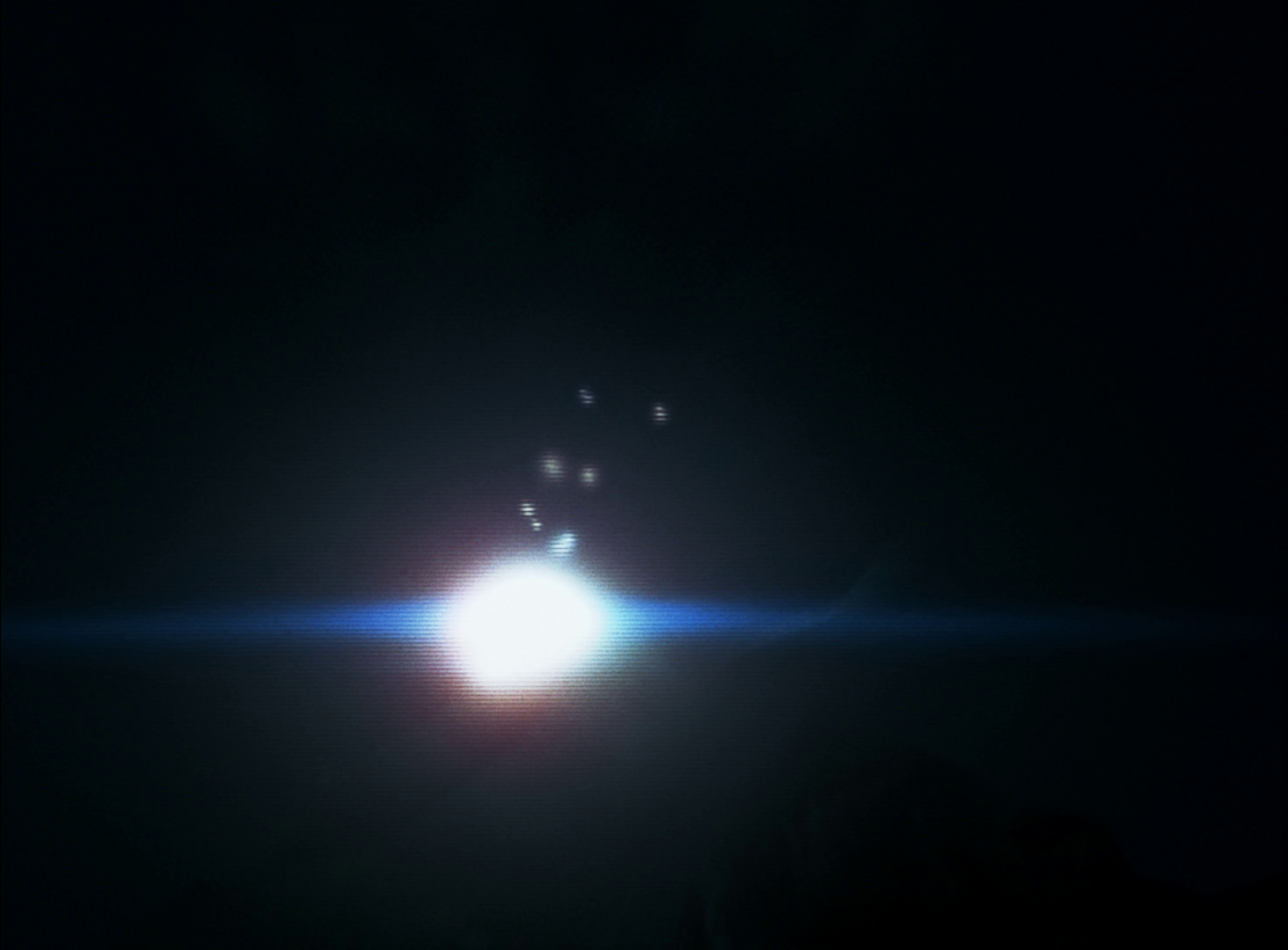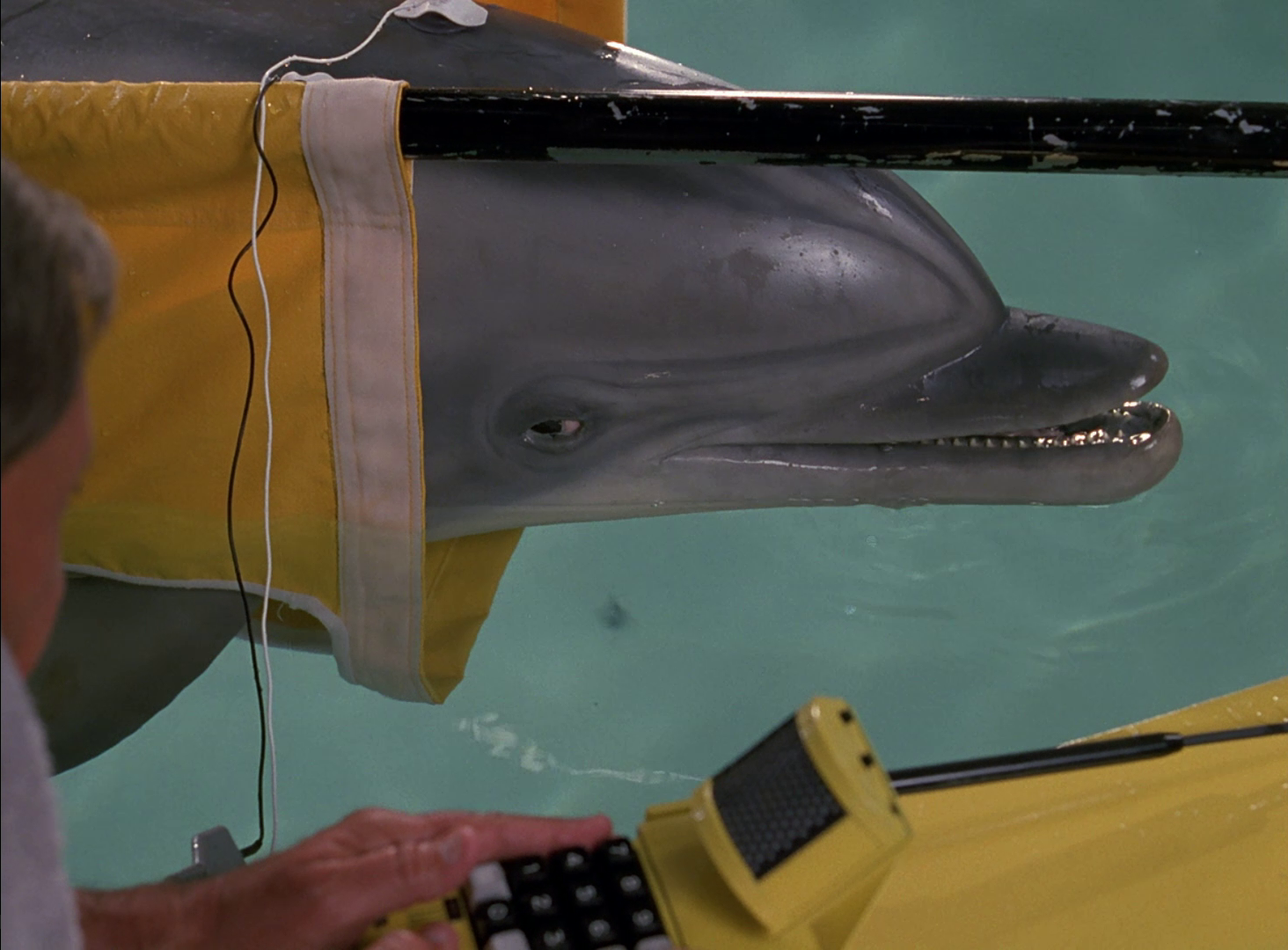 Universal’s home video operation has been cranking out rescanned, remastered Blu-Ray sets of its back TV catalog – The Six Million Dollar Man, The Bionic Woman, Knight Rider, The Incredible Hulk, Quantum Leap – with aplomb, and you know, good for them. It’s neat to see these old shows get a little bit of TLC, and as most of them hail from an era when special effects were primarily opticals achieved on film, it’s an easy proposition to just rescan the film at HD resolution. But with seaQuest DSV, we’re in different territory. The late ’80s saw a shift to a videotape workflow for most post-production, which made shows such as Star Trek: The Next Generation possible within a budget, even if the show’s footage was shot on film. Once that film footage was telecined over to videotape, the entire post-production process was done in the videotape realm. And with the advent of Babylon 5 and its 100% CGI effects pipeline, there were portions of shows that only ever existed on videotape and never touched film even once. seaQuest DSV, which premiered in the fall of 1993 (months after Babylon 5’s premiere, and an Emmy win for the Video Toaster-based effects of its pilot movie), is like that: its underwater “exteriors” were creatures of the digital realm, outputted only to videotape and edited into the show in post production. They don’t exist on film and can’t be rescanned at a higher resolution, because they exist only at the resolution of videotape. This set becomes a case study in how ’90s TV – especially ’90s genre TV – might make it to Blu-Ray.
Universal’s home video operation has been cranking out rescanned, remastered Blu-Ray sets of its back TV catalog – The Six Million Dollar Man, The Bionic Woman, Knight Rider, The Incredible Hulk, Quantum Leap – with aplomb, and you know, good for them. It’s neat to see these old shows get a little bit of TLC, and as most of them hail from an era when special effects were primarily opticals achieved on film, it’s an easy proposition to just rescan the film at HD resolution. But with seaQuest DSV, we’re in different territory. The late ’80s saw a shift to a videotape workflow for most post-production, which made shows such as Star Trek: The Next Generation possible within a budget, even if the show’s footage was shot on film. Once that film footage was telecined over to videotape, the entire post-production process was done in the videotape realm. And with the advent of Babylon 5 and its 100% CGI effects pipeline, there were portions of shows that only ever existed on videotape and never touched film even once. seaQuest DSV, which premiered in the fall of 1993 (months after Babylon 5’s premiere, and an Emmy win for the Video Toaster-based effects of its pilot movie), is like that: its underwater “exteriors” were creatures of the digital realm, outputted only to videotape and edited into the show in post production. They don’t exist on film and can’t be rescanned at a higher resolution, because they exist only at the resolution of videotape. This set becomes a case study in how ’90s TV – especially ’90s genre TV – might make it to Blu-Ray.
First, of course, there has to be demand for the material – we’ve seen Farscape and now seaQuest upgraded to HD, but is anyone clamoring for Lexx in the same format? Additionally, it’s almost a non-starter if the original film doesn’t exist somewhere to be rescanned. Even with the cheaper workflow of videotape, special effects were still expensive for ’90s genre TV; most of the show will still exist on film, with as much achieved in-camera as possible. (This is a big part of why Star Trek: Deep Space Nine and Voyager, with their green-screened viewscreens and monitors galore, remain stranded in standard definition.) This leaves only brief sequences to be upscaled, and of course there’s now AI upscaling to streamline that process. There’s a precedent for this process too: HBO Max’s HD upgrade of all five seasons of Babylon 5’s weekly episodes was just such a hybrid: rescanning the necessary original film at HD resolution, but AI upscaling effects sequences and any scenes with composited live action and effects from the original broadcast videotape masters.
But there’s a middle step too: anything upscaled from tape has to be digitally converted to a progressive scan format; ’90s videotape was an interlaced format, to suit how CRT televisions displayed a picture, but modern high-definition television is displayed differently, hence the “p” at the end of such common resolutions as 720p or 1080p. Displaying interlaced video at high resolution can sometimes produce a noticeable, and possibly distracting, “venetian blinds” effect as parts of the picture don’t seem to move at the same rate. When HBO Max upscaled Babylon 5’s effects, they were converted to progressive scan first; the effects sequences from seaQuest DSV were not treated to the same process. For most of the fully-digital “underwater” shots, where things tend to moves slowly to convey the sensation of moving through water, the effects shots are fine. But in more active scenes, with fast-moving undersea vessels, those “venetian blinds” have been upscaled with the rest of the picture.
So, for every episode of seaQuest DSV that’s gotten an HD upgrade, there’s that caveat. Some viewers may notice it, some may not. (Full disclosure: this reviewer has worked in broadcast engineering environments in both the standard-def and HD eras, so he tends to spot stuff like this.) Other than that, however, this set has a lot to recommend it. The picture is bright, sharp, and clear when it comes from a non-composited film source. In fact, almost too clear in places: with things like the animatronic prop of Darwin the talking dolphin, the vastly sharpened picture means that you can see that it’s a prop and not a living creature. Sometimes upgrading standard-def TV to HD means that you’ll be seeing some of the seams that the lower resolution of a CRT gracefully hid from view.
And, no joke, let’s reflect on the privilege we have of now seeing, in HD, two-seasons-and-change of Roy Scheider performances. The fact that he was going to be the show’s lead was the key to my interest in this series during its original broadcast run, because he’s simply a hell of an actor, the humanity of his characters on full display in every frame. The good news is, when he was surrounded by younger, less experienced cast members, they either had to bring their A-game to share a scene with Scheider – or they sank out of view in those same scenes, pun painfully intended. This, and the heavily-touted (even on this set’s packaging) involvement of executive producer Steven Spielberg, brought serious guest star power to bear on the show as well: Charlton Heston, William Shatner, Udo Kier, Mark Hamill, Dom DeLuise…seaQuest was one of the last gasps of network “event” TV intersecting with genre TV. (I’m also obligated to point out that another high-ranking producer on seaQuest was Philip David Segal, who later brought us the Paul McGann Doctor Who TV movie.)
This set also brings something to the table that has been conspicuous by its absence on previous North American home video releases: the entire third season of the show. The oft-maligned seaQuest 2032 makes its North American home video debut in this set, having previously been available only in DVD sets produced for markets outside the U.S. With Roy Scheider reduced to a handful of guest shots, much of the regular cast ejected, and Michael Ironside as the new captain of seaQuest, the third season is darker and less utopian, with a significant time jump forward into a world at constant low-key war. In revisiting this season for the first time since it was originally broadcast, I find that it’s better than I initially gave it credit for.
In hindsight, the whole series, despite the fact that the basic formulation of the show was rethought between every season, is better than the snark-loaded reputation it seems to have these days. The first season does a nice job of building a future world to fits its stories, the second season begins to suggest that there may be darker things lurking beneath that world, and the third throws that world into disarray to test that world, and its characters, to their limits. And yes, that world includes a teenage ensign and a talking dolphin that may make it easy to write the whole show off as juvenile, but in a world where COVID still hasn’t been wished away and we’re dealing with dystopian plotting aplenty in the evening news and not just in fiction, you know what? Give me a world like this instead. Just as a brief escape.
Even if there’s an episode with goofy giant CGI crocodiles that were barely threatening in standard-definition, but are decidedly not-threatening-at-all in HD.







